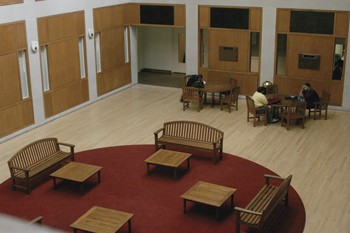
The members of Mustache Envy, a current Dallas show that includes Tuesday Night’s speaker Whitney Copeland (back left). (Courtesy of Arnold Wayne Jones)
The Women’s Interest Network invited a professional burlesque dancer to talk about women’s empowerment and gender Expression through the art Tuesday night at Hughes-Trigg.
Social worker by day and burlesque dancer by night, Whitney Copeland, showed the Women’s Interest Network that burlesque dancing is “something to be proud of.”
“Burlesque is really about being confident in your own body and loving who you are,” Copeland said.
This type of dance incorporates contemporary and retro dancing like jazz, modern dancing, swing, ballet and belly dancing in a dark, sexier way.
Today, burlesque carries many traits from belly dancing, its main influence.
The Women’s Interest Network is a student organization that strives to empower women within the SMU and Dallas community.
With guest speakers, performances and other activities, the Women’s Interest Network tries to provide resources and help for women to deal with daily issues. Some feminists feel burlesque, like stripping, objectifies women.
“I think it really goes hand and hand with feminism. I’m comfortable because I’m not a subject to my [or anyone’s] oppression,” Copeland said.
The dancer explained that by dancing she owns her body allowing her to be in control to do what she wants.
She also stressed that dancing makes her extremely proud of her body and that feminists who oppose it should attend shows and learn more about the dance.
“What caught me off guard the first time I saw a burlesque show was how interactive it was. The host would just say: ‘yeah scream, call her [names], anything’,” SMU student and Women’s Interest Network secretary Samuel Partida said.
The “calling of names” comes from the influences of belly dancing.
While women were belly dancing, the audience was supposed to encourage them and their art by yelling “Ofhah.”
Copeland explained that burlesque is more about the tease than the actual end result. This is one of the differences between burlesque and stripping.
Even though both dances are often categorized as the same, burlesque women are never completely nude or take money from the audience.
“Burlesque is starting to come into mainstream culture a lot more with like the X-Factor and [the movie] ‘Burlesque’,” commented SMU transfer student Angela Uno.
Copeland said that burlesque is becoming more acceptable, but the movie failed to show exactly how it is.
She says the industry is more on your own, making your own costumes and without backup dancers.
Copeland started burlesque her sophomore year of college as a fun alternative to lose weight.
After a few classes, she realized that dancing made her feel happy and confident. Dance became a form of expressing and loving herself.
Now she and her partner are part of the Mustache Envy, a show that plays in Dallas the first Friday of every month at different locations.
Burlesque is also an outlet for gender expression.
“By participating in Mustache Envy, I show that, yes, this is how I express my gender but I love the way you express your gender, also.”
“And that’s how I show that I don’t believe in gender dichotomy,” Copeland said.
The audience unanimously agreed with the dancer by clapping.
Like any other dance, burlesque has a basic structure, but Copeland ensured the audience it can be self-taught “if you watch videos, read about it [and] try to do your own costuming.”
The dancer ended by incorporating the audience and teaching them some of the basic moves of burlesque dancing.
Among some of the moves were shoulder shimmy, hip bump switch and hip shimmy.
“I’m taking notes for like Drag right now,” Partida said.









